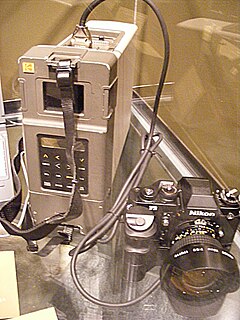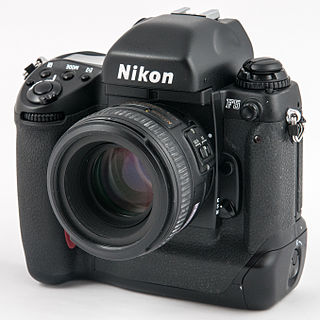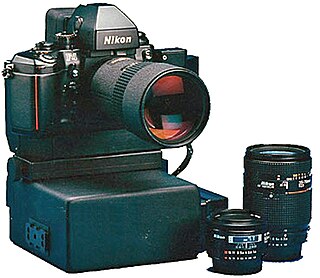

The Kodak DCS 400 series was a series of Nikon based digital SLR cameras with sensor and added electronics produced by Eastman Kodak. It was part of Kodak's DCS (Digital Camera System) line.
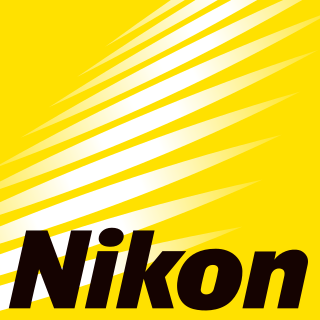
Nikon Corporation, also known just as Nikon, is a Japanese multinational corporation headquartered in Tokyo, Japan, specializing in optics and imaging products.

A camera is an optical instrument to capture still images or to record moving images, which are stored in a physical medium such as in a digital system or on photographic film. A camera consists of a lens which focuses light from the scene, and a camera body which holds the image capture mechanism.

The Kodak Digital Camera System is a series of digital single-lens reflex cameras and digital camera backs that were released by Kodak in the 1990s and 2000s, and discontinued in 2005. They are all based on existing 35mm film SLRs from Nikon, Canon and Sigma. The range includes the original Kodak DCS, the very first commercially available digital SLR.
Contents
The cameras in this series include the 1.5-megapixel DCS 420 (introduced in August 1994), the 1.5-mpx DCS 410 (introduced in 1996), and the 6.2-mpx DCS 460 (introduced in March 1995). In addition, Kodak sold a version of the back from the DCS 460 adapted for medium format bodies as the DCS 465. Kodak also made a camera especially for Associated Press. It was called NC2000 (based on the Nikon N90/F90), later upgraded to NC2000e (based on the Nikon N90s/F90x) using many of the same components as were used for the DCS 400 series. Kodak also used the imaging component and electronics of the DCS 420 to produce a digital version of the Nikonos underwater camera, which was produced in limited numbers for military and scientific applications as the Kodak DCS 425.
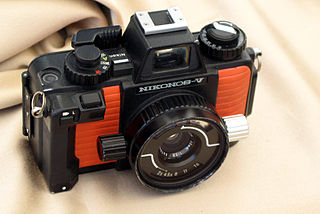
Nikonos is the brand name of a series of 35mm format cameras specifically designed for underwater photography launched by Nikon in 1963. The early Nikonos cameras were improvements of the Calypso camera, which was an original design by Jacques-Yves Cousteau and Belgian engineer Jean de Wouters. It was produced in France by La Spirotechnique until the design was acquired by Nikon to become the Nikonos. The Nikonos system was immensely popular with both amateur and professional underwater photographers. Its compact design, ease of use, and excellent optical quality set the standard for several decades of underwater imaging. Nikon ceased development and manufacture of new Nikonos cameras in 2001, but the camera remains popular, and there is a large and active secondary market.
In addition to the standard colour version, Kodak made monochrome and infrared versions of the DCS 420, which were made to order as the 420m and 420IR respectively. There were also monochrome versions of the DCS 460 and DCS 465, with the same nomenclature. The non-colour versions are very rare and tend to collect high prices at auctions and second-hand brokers.
The DCS 400-series were based on the Nikon N90s 35 mm film camera (called F90x in Europe). The DCS 410 and some early versions of the DCS 420 and 460 were based on the Nikon N90/F90 body. After the Nikon N90s/F90x was introduced in late 1994, Kodak started using that model as basis for the DCS 400-series. The camera body could be converted back to a film camera by removing the digital component, and replacing the digital back with a standard back.

135 is photographic film in a film format used for still photography. It is a cartridge film with a film gauge of 35 mm (1.4 in), typically used for hand-held photography in 35 mm film cameras. Its engineering standard for the film is controlled by ISO 1007.
All cameras in the series used a 12 bit/channel CCD. The 1.5 Mpx sensor used in the DCS 410 and DCS 420 measures 9.2x13.8 mm (2.6x crop factor compared to the 35 mm film format). The 6.2 Mpx sensor used in the DCS 460 and DCS 465 measures 18.4x27.6mm (1.3x crop). The 1.3 Mpx sensor used in the NC2000 and NC2000e measures 16.4x20.5mm (1.6x crop) with an unusual aspect ratio (5:4).

In digital photography, the crop factor, format factor or focal length multiplier of an image sensor format is the ratio of the dimensions of a camera's imaging area compared to a reference format; most often, this term is applied to digital cameras, relative to 35 mm film format as a reference. In the case of digital cameras, the imaging device would be a digital sensor. The most commonly used definition of crop factor is the ratio of a 35 mm frame's diagonal (43.3 mm) to the diagonal of the image sensor in question; that is, CF=diag35mm / diagsensor. Given the same 3:2 aspect ratio as 35mm's 36 mm × 24 mm area, this is equivalent to the ratio of heights or ratio of widths; the ratio of sensor areas is the square of the crop factor.
In 1995, the DCS 460 was the highest resolution digital camera available and its list price was US$35,600. [1] When it closed out in November 2000, the price had dropped to US$2,500. [2]








